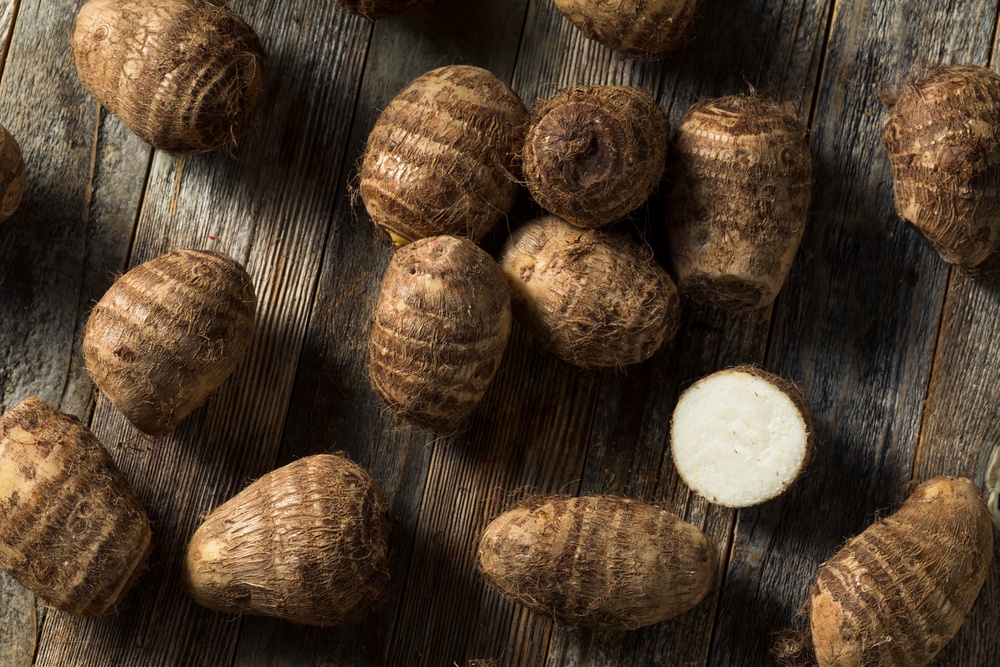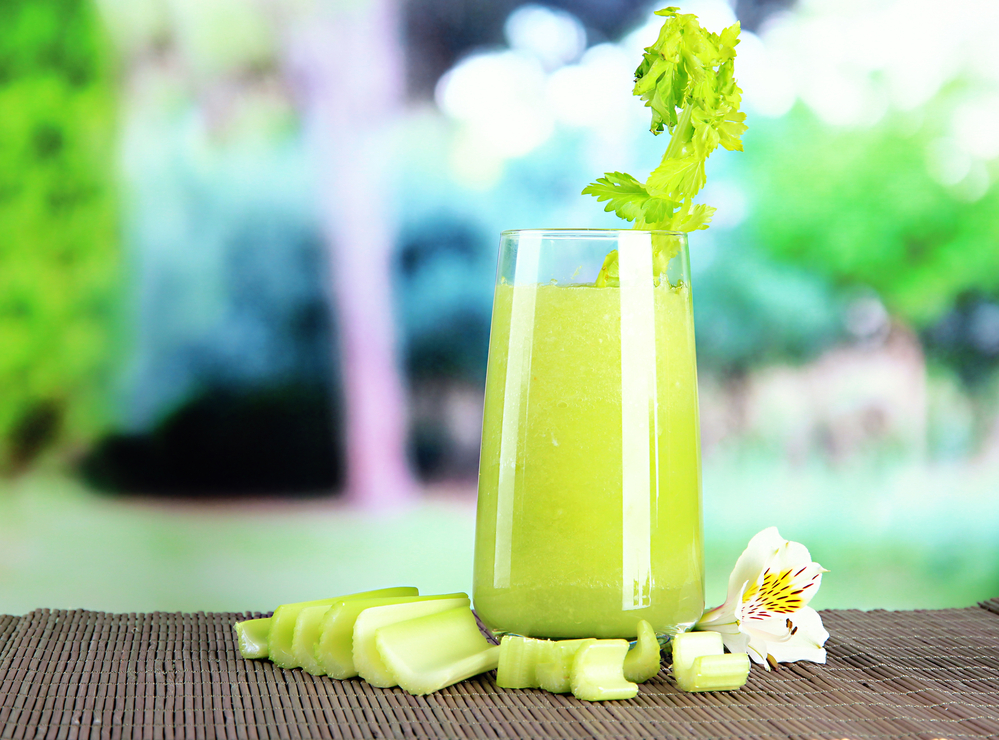Lotus root is a staple ingredient in many Asian dishes, but for those who have never tried it, the taste and texture can be a mystery. This edible rhizome, which comes from the lotus flower, can be eaten raw or cooked and has a unique taste and texture that sets it apart from other vegetables.
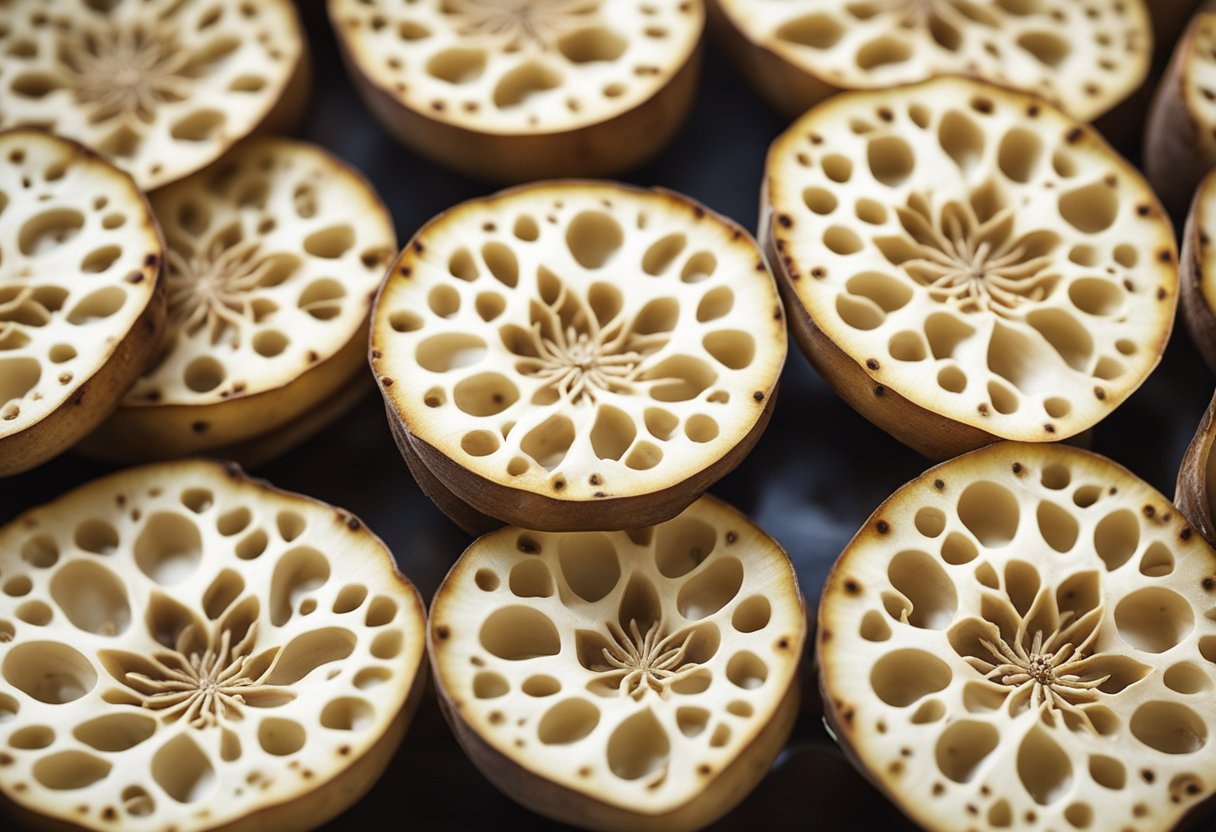
When it comes to taste, lotus root is mild and slightly sweet, with a subtle nuttiness and a slightly bitter undertone. The texture is crisp and fibrous, similar to celery, and the holes in the root make it an interesting addition to any dish.
Lotus root is known for its ability to absorb the flavors of other ingredients in a recipe, making it a versatile and tasty addition to soups, stews, and stir-fries.
Overall, lotus root is a delicious and nutritious vegetable that is worth trying for anyone looking to expand their culinary horizons. Whether you’re a seasoned chef or a beginner in the kitchen, there are many different ways to prepare and enjoy this unique ingredient.
Key Takeaways
- Lotus root has a mild, slightly sweet taste with a subtle nuttiness and a slightly bitter undertone.
- The texture is crisp and fibrous, similar to celery, and the holes in the root make it an interesting addition to any dish.
- Lotus root is a versatile and tasty addition to soups, stews, and stir-fries, and is a delicious and nutritious vegetable worth trying.
Understanding Lotus Root

Lotus root is an edible rhizome, a bulb from the flower of the same name that can be peeled, sliced, and eaten raw or cooked. This aquatic plant is native to Asia, particularly India, and can be found growing in ponds and other shallow bodies of water.
The lotus plant is grown for its beautiful flowers and its edible roots, which have been used in traditional medicine for centuries.
The lotus root is a long, tubular vegetable that looks like a sausage. It has a hard, brown skin that needs to be peeled before eating. Once peeled, the lotus root reveals a white, starchy flesh that is crunchy and slightly sweet. The texture is similar to that of a potato or a water chestnut.
The lotus root is a versatile vegetable that can be cooked in a variety of ways. It can be sliced and stir-fried, boiled, roasted, or grilled. It can also be pickled or used in soups and stews. The lotus root is often used in Asian cuisine, particularly in Chinese, Japanese, and Korean dishes.
One of the unique characteristics of the lotus root is that it is an underwater vegetable. The lotus plant grows in ponds and other shallow bodies of water, and the roots are submerged in the mud at the bottom of the pond. This gives the lotus root a distinct flavor and texture that is different from other vegetables.
In conclusion, the lotus root is a delicious and nutritious vegetable that has been used in traditional medicine for centuries. It has a mild, slightly sweet flavor and a crunchy texture that is similar to that of a water chestnut.
The lotus root is a versatile vegetable that can be cooked in a variety of ways and is often used in Asian cuisine.
Taste and Texture of Lotus Root
Lotus root is a versatile vegetable that has a mild, slightly sweet taste with an earthy, slightly bitter undertone. It has a firm, crunchy texture that makes it a popular ingredient in many different dishes, from soups and stews to stir-fries and salads.
When cooked, lotus root has a starchy texture that adds depth and complexity to any dish. It is also excellent at absorbing the flavors of other ingredients, making it a great addition to any recipe.
One of the unique features of lotus root is its numerous air pockets, which give it a distinctive appearance. These holes also help to store sauce in a similar way to tubular pasta, making it an ideal ingredient for dishes with rich, flavorful sauces.
Overall, lotus root is a delicious and nutritious vegetable that can be enjoyed in a variety of ways. Its mild, slightly sweet taste and crunchy texture make it a popular ingredient in many Asian cuisines, while its versatility and ability to absorb flavors make it a great addition to any recipe.
Culinary Uses of Lotus Root
I have always been fascinated by the unique flavor and texture of lotus root. This versatile ingredient is commonly used in Asian cuisine, and it can be enjoyed in a variety of dishes. Here are some of the culinary uses of lotus root that I have come across:
Raw
One of the simplest ways to enjoy lotus root is to eat it raw. When sliced thinly, it has a crisp texture similar to that of celery. You can use a mandoline slicer to get thin, even slices. Raw lotus root has a mild, slightly sweet flavor that pairs well with dips and sauces.
Boiled or Steamed
Lotus root can be boiled or steamed until tender and then used in soups or stews. It is often added to hot pot dishes in China and Japan. When cooked, lotus root becomes soft and slightly sticky, making it a great addition to hearty stews.
Fried
Lotus root chips are a popular snack in Asia. To make them, lotus root is sliced thinly and then fried until crispy. The chips can be seasoned with salt, vinegar, or lemon juice for added flavor.
Stir-Fried
Lotus root can also be stir-fried with other vegetables and meats. It adds a unique texture to stir-fries, and its mild flavor makes it a great complement to bolder ingredients like sausage or chili oil. When stir-fried, lotus root should be sliced thinly and cooked over high heat to maintain its crisp texture.
Baked
For a healthier alternative to fried lotus root chips, you can also bake them in the oven. Simply toss sliced lotus root with olive oil and salt, and then bake at 375°F for about 15-20 minutes, or until crispy.
Baked lotus root chips can be seasoned with a variety of spices, such as garlic powder or chili flakes.
Pickled
Pickled lotus root is a popular side dish in Japan. To prepare it, lotus root is sliced thinly and then pickled in a mixture of vinegar, sugar, and salt. The pickling process gives the lotus root a tangy, slightly sweet flavor that pairs well with rice and other dishes.
Overall, lotus root is a versatile ingredient that can be enjoyed in a variety of ways. Whether you prefer it raw, boiled, fried, or pickled, lotus root adds a unique texture and flavor to any dish. When storing lotus root, keep it in a cool, dry place and use it within a week of purchase for best results.
Storing and Preparing Lotus Root
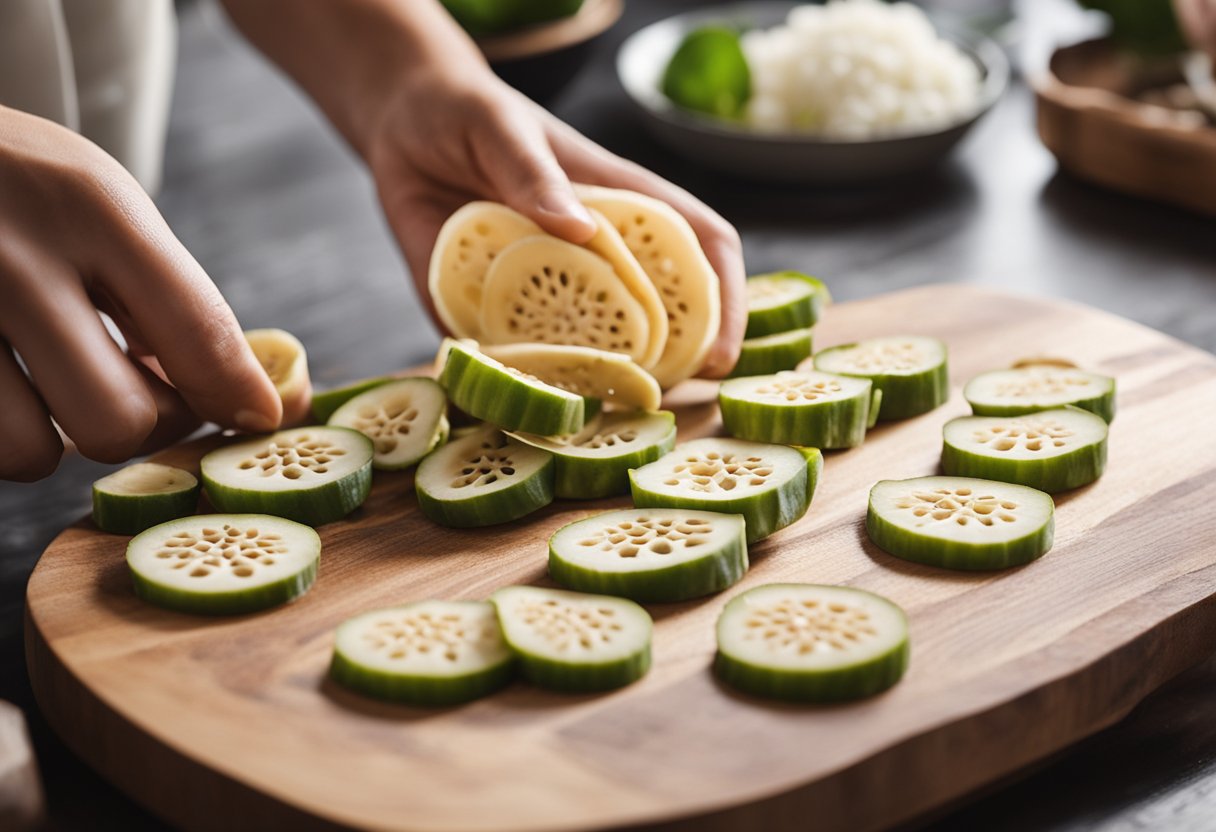
As with any fresh produce, proper storage of lotus root is essential to maintain its quality and freshness. Here are some tips for storing and preparing lotus root:
Storing
- Choose lotus roots that are firm, heavy, and free of bruises or blemishes.
- Store uncut lotus roots in the refrigerator wrapped in paper towels or a damp cloth and placed in a plastic bag. They can last up to two weeks, but it’s best to use them within a week.
- Avoid storing lotus roots near ethylene-producing fruits like apples and bananas, as this can cause them to spoil faster.
Preparing
- Before preparing lotus root, wash it thoroughly under running water to remove any dirt or debris.
- Peel the skin using a vegetable peeler or a sharp knife, being careful not to remove too much of the flesh.
- Cut the lotus root into thin slices or chunks, depending on your recipe.
- If you’re not using the lotus root immediately, place it in a bowl of cold water to prevent discoloration.
Lotus root has a mild flavor and a slightly crunchy texture, making it a versatile ingredient in many dishes. It’s commonly used in stir-fries, soups, and salads. So, with these tips, you can store and prepare lotus root like a pro!
Nutritional Value and Health Benefits of Lotus Root

Lotus root is an edible rhizome that is widely used in Asian cuisine. It is a great source of vitamins, minerals, and fiber, making it a healthy addition to any diet. In this section, I will discuss the nutritional value and health benefits of lotus root.
Nutritional Value
Lotus root is low in calories and high in fiber, making it an excellent choice for those looking to maintain a healthy weight.
A 100-gram serving of raw lotus root contains approximately 74 calories and 2.5 grams of fiber. It is also a good source of vitamins and minerals, including vitamin C, calcium, iron, and potassium.
Health Benefits
Lotus root has several health benefits, including improved digestion, reduced cholesterol levels, and increased energy levels. It is also a great source of antioxidants, which can help protect the body from damage caused by free radicals.
One of the key health benefits of lotus root is its high fiber content. Fiber is essential for maintaining a healthy digestive system and can help prevent constipation and other digestive issues.
Additionally, lotus root contains a compound called oligosaccharides, which can help promote the growth of beneficial bacteria in the gut.
Lotus root is also low in cholesterol and saturated fat, making it a heart-healthy food. It contains potassium, which can help regulate blood pressure and reduce the risk of heart disease.
Additionally, lotus root has been shown to improve energy levels and reduce fatigue, making it a great choice for those looking to increase their physical activity.
In conclusion, lotus root is a nutritious and delicious addition to any diet. It is low in calories, high in fiber, and packed with vitamins and minerals. Whether you enjoy it raw or cooked, lotus root is a versatile ingredient that can be used in a variety of dishes, from stir-fries to rice dishes.
Lotus Root in Different Cultures

Lotus root is a popular ingredient in many Asian cuisines, including Chinese, Japanese, and Indian. It is used in a variety of dishes, from soups to stir-fries, and is known for its crunchy texture and mild, slightly sweet taste.
In China, lotus root is often used in hot pot dishes, where it is cooked in a flavorful broth along with other ingredients like meat, vegetables, and noodles. It is also used in stir-fries, where it adds a satisfying crunch to the dish. In Japan, lotus root is often sliced thinly and used as a garnish for sushi or added to stews and soups.
In India, lotus root is used in a variety of dishes, including curries and stir-fries. It is often combined with other vegetables like potatoes, carrots, and peas, and flavored with spices like cumin, coriander, and turmeric.
Overall, lotus root is a versatile ingredient that can be used in a variety of dishes and cuisines. Its mild, slightly sweet taste and crunchy texture make it a popular addition to many recipes.
Conclusion

In conclusion, Lotus root is a versatile and delicious root vegetable that is definitely worth trying. It has a mild, sweet flavor and a crunchy texture, similar to celery. The lotus root is a part of the lotus flower pattern and is divided into two types: red and white.
Lotus root is often used as a substitute for potatoes in many dishes. It can be boiled, fried, or even pickled. It is a popular ingredient in many Southeast Asian and Japanese cuisines.
The lotus root is not only delicious but also packed with nutrients. It is low in cholesterol and saturated fat, and it is rich in vitamin C and a good source of dietary fiber, vitamin B6, thiamin, phosphorus, potassium, copper, and manganese.
In terms of uses, lotus root can be used in many different ways. It can be sliced and added to stir-fries, soups, and stews. It can also be used as a base for salads and dips. Additionally, it can be used as a garnish or decorative element in many dishes.
Overall, lotus root is a unique and flavorful ingredient that can add a lot of depth and texture to your dishes. It is definitely worth trying if you are looking for something new and exciting to add to your meals.
Frequently Asked Questions
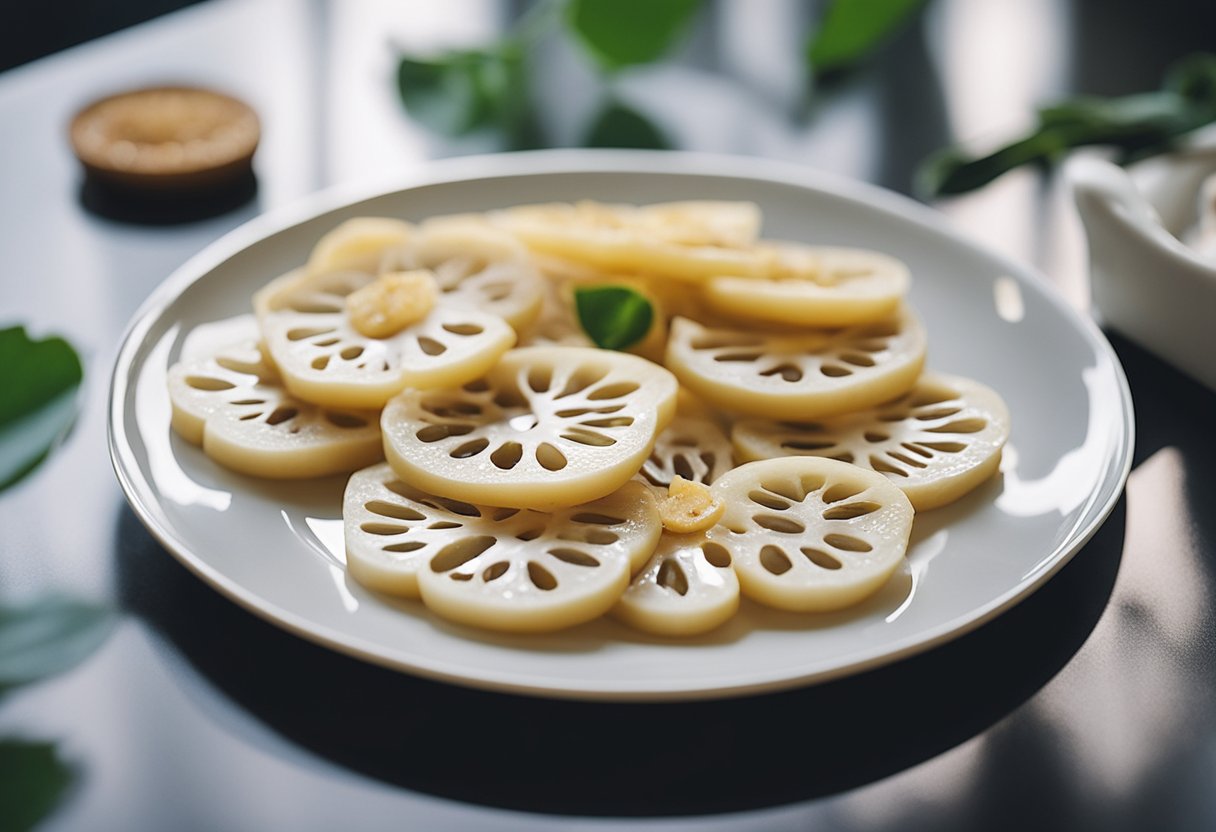
Where can I buy lotus root?
Lotus root can be found at Japanese or other Asian grocery stores and may even be found at farmers markets. When buying lotus root, look for firm roots with a smooth and unblemished skin. It is best kept in the refrigerator and when it is ready to be used, trim the ends and peel the outer skin.
What are the nutritional benefits of lotus root?
Lotus root is a good source of dietary fiber, vitamin C, vitamin B6, thiamin, riboflavin, phosphorus, copper, and manganese. It is also low in calories and fat.
The high fiber content of lotus root helps to promote digestive health, while the vitamin C content helps to support a healthy immune system.
How many calories are in lotus root?
One cup of sliced lotus root contains approximately 66 calories. It is a low-calorie food that is a great addition to any healthy diet.
Can lotus root be eaten raw?
Yes, lotus root can be eaten raw. It has a mild flavor and crunchy texture that makes it a great addition to salads or as a snack.
What does lotus seed taste like?
Lotus seeds have a nutty and slightly sweet flavor. They are often used in Asian desserts and can also be roasted and eaten as a snack.
Who should avoid consuming lotus root?
Individuals who are allergic to lotus root or have a history of allergic reactions to other plants in the water lily family should avoid consuming lotus root.
Additionally, pregnant or breastfeeding women should consult their healthcare provider before consuming lotus root as there is limited research on its safety during pregnancy and breastfeeding.




